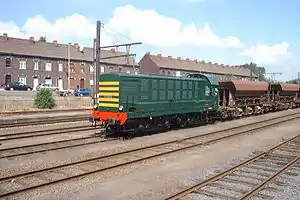Belgian Railways Class 70
Class 270 (later reclassified as Class 70) locomotives were the first diesel shunters used by NMBS/SNCB. Three were initially ordered as prototypes of diesel-electric traction. Three diesel-hydraulic Class 271 locomotives were also ordered for comparison.
| Class 70 | |||||||||||||||||||
|---|---|---|---|---|---|---|---|---|---|---|---|---|---|---|---|---|---|---|---|
 7005 (bearing original number 270005) 29 June 2002. | |||||||||||||||||||
| |||||||||||||||||||
| |||||||||||||||||||
| |||||||||||||||||||
| |||||||||||||||||||
One loco, 7005, has been preserved by PFT at Saint Ghislain; the others were scrapped after being replaced by class 77s.[1]
History
Built by Belgian locomotive manufacturers Baume & Marpent, the 6 class 270 locomotives were initially allocated to Ronet depot, near Namur. Their electric transmission was produced by ACEC, under licence from Westinghouse. During 1992, 7004 acquired a Cockerill diesel engine to replace its original Anglo Belgian Corporation unit.[2]
After Ronet, during 1961 they were moved on to Antwerp to perform trip workings to and from places such as Boom, Mechelen, Mol and Turnhout.[3] When, at the start of 1971, NMBS/SNCB adopted their current numbering system they became Class 70.
References
| Wikimedia Commons has media related to SNCB Class 70. |
- De Neef, David (2004-08-26). "Locomotives de manoeuvre de la série 70" (in French). Retrieved 2008-02-04.
- De Jonghe, Henk. "PFT/TSP - 270.005". Retrieved 2008-02-04.
- Malisoux, Charles (November 2002). "Le rond-point nu" (in French). Retrieved 2008-02-04.